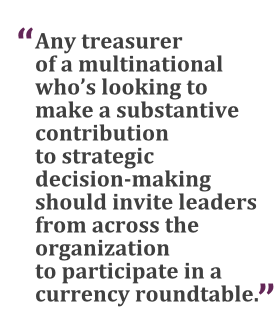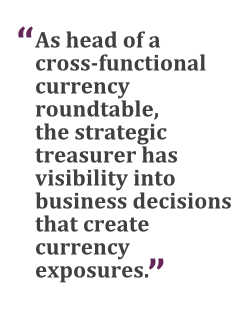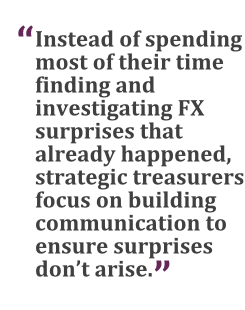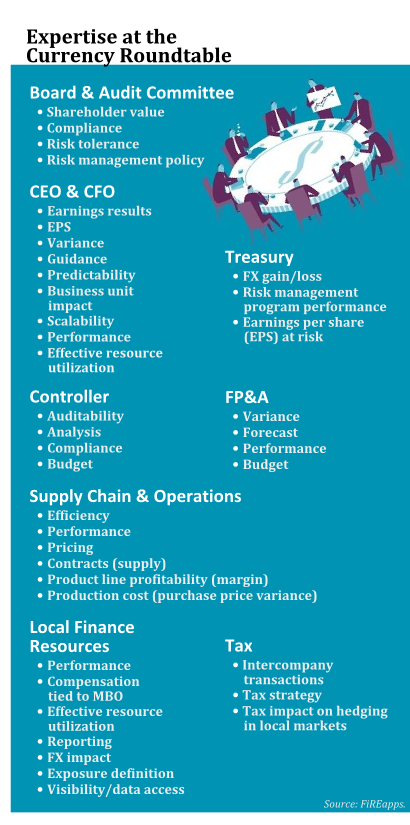 A recent Treasury & Risk article described the results of a Deloitte survey as pointing to an “evolution” of the corporate treasurer “from number cruncher to partner in strategic decision-making.” That evolution is occurring at the same time that shifts in currency exchange rates are having an increasingly serious impact on financial statements in every corner of the organization.
A recent Treasury & Risk article described the results of a Deloitte survey as pointing to an “evolution” of the corporate treasurer “from number cruncher to partner in strategic decision-making.” That evolution is occurring at the same time that shifts in currency exchange rates are having an increasingly serious impact on financial statements in every corner of the organization.
Volatility is way up this year in most major currencies. And when, for example, the once-stable Swiss franc rises in value by 30 percent in a single day, that swing will affect predictability and budgets from the C-suite to financial planning and analysis. Likewise, consider how the plummeting value of the euro would impact the supply chain and operations teams in a company that is purchasing goods in pounds sterling or dollars as inputs to a product that will sell in euros.
The value of a strategic corporate treasurer extends in both directions: A strategic treasurer can help each corporate function take currency risks into consideration when making decisions around supply chain management, pricing and sales terms, outsourcing, expansion plans, and many other areas of the business. While at the same time, when other corporate functions are consulting regularly with the strategic treasurer, that dialogue gives treasury a more comprehensive global view that helps with optimizing the management of currency risk for the business overall.
Building a Cross-Functional Currency Roundtable
In the context of managing currency risk, what does it mean to be a “strategic” treasurer? Over the course of more than a decade of work with hundreds of organizations, we've found that truly strategic treasurers tend to have five traits in common:
- Strategic treasurers understand where in the organization exposures are being created.
- They are empowered to impact company policy.
- They have access to accurate, complete, and timely data.
- They address currency volatility proactively, often answering questions before they're even asked.
- And, finally, they often pull together a “currency roundtable” that includes the right people to strategically consult from a wide variety of corporate functions.
This last point is crucial, and it represents the best practice in managing foreign exchange (FX) exposures. Any treasurer of a multinational organization who's looking to make a substantive contribution to the company's strategic decision-making should invite leaders from across the organization to participate in an ongoing collaborative dialogue about how currency is impacting the company and how best to manage that risk. The currency roundtable needs to include one or more representatives of each of these groups:
Board of directors. The corporate board and its audit committee have a fiduciary responsibility to the company's shareholders. The person representing the board on the currency roundtable brings to the table a focus on issues around shareholder value, compliance, and the company's risk tolerance.
 This member of the roundtable is part of the small group that defines risk tolerance and has oversight responsibility to make sure all appropriate controls are in place to limit risk to shareholder value. So he or she should encourage the roundtable to answer questions such as: Have we defined how much risk we're willing to accept and set an associated risk management policy for the organization? And are we effectively communicating the impact of currency surprises on shareholder value to all of the relevant constituents (investors, analysts, Wall Street, etc.)?
This member of the roundtable is part of the small group that defines risk tolerance and has oversight responsibility to make sure all appropriate controls are in place to limit risk to shareholder value. So he or she should encourage the roundtable to answer questions such as: Have we defined how much risk we're willing to accept and set an associated risk management policy for the organization? And are we effectively communicating the impact of currency surprises on shareholder value to all of the relevant constituents (investors, analysts, Wall Street, etc.)?
Executive management. The CEO and CFO are focused on business strategy and the overall performance of the company. They embody what the level of risk tolerance currently is, and what it will be on a go-forward basis, based on their understanding of future plans for operations. The executive perspective is grounded in pure financial metrics. Because the buck stops with them in terms of currency impact, both executives should have a seat at the currency roundtable.
Their contributions to the discussion may touch on topics such as corporate financial results, resource utilization, and the impact of different currency considerations on specific business units. Both within the roundtable and in other settings, the CEO and CFO look to treasury to explain how currency volatility can be expected to affect financial performance measures such as revenue, EBITDA, and earnings per share.
Accounting. The corporate controller is the custodian of the company's accounting data and is responsible for disseminating that information throughout the organization. Accounting managers are the rule-setters who determine which accounts get counted in and out from an exposure perspective. Representatives of accounting are at the currency roundtable to provide insight into compliance and control issues that may arise due to currency volatility. When the company is impacted by currency volatility, the controller must understand whether the organization's financial results are an accurate reflection of what happened in the business, and whether the FX impact reflects a data integrity issue or is an outcome of currency management. The currency roundtable is the right place to pose these sometimes complex questions and to collaborate around solutions to these problems.
Regional finance teams. In each region where the company operates, there are likely local finance resources who are responsible for the performance of their entities or units. These individuals bring to the corporate currency roundtable a ground-level understanding of their business. They are as close to the market as you can physically get and are the stakeholders with “tribal knowledge” that help build informed currency forecasts. Additionally, compensation for these individuals may change significantly depending on performance. As a result, in some cases, currency swings affect the compensation of the local business leaders.
 Regional finance teams are frequently grappling with the challenge of deploying appropriate resources to satisfy corporate reporting requirements and meet the needs of business management around currency risk mitigation. The currency roundtable can give them more of a bird's-eye visibility into organizational risks.
Regional finance teams are frequently grappling with the challenge of deploying appropriate resources to satisfy corporate reporting requirements and meet the needs of business management around currency risk mitigation. The currency roundtable can give them more of a bird's-eye visibility into organizational risks.
FP&A. The financial planning and analysis team is responsible for explaining what has happened (impact analysis) and what could happen (scenario analysis) in the business. The person in this chair at the roundtable needs to work with the other participants to answer several key questions: To what degree did currency impact the company in the last month/quarter/etc.? How much of that impact was volume, and how much of it was rate? How much did currency issues move our actual reported results away from budget and forecasts? If a specific currency moves 5 percent in the next quarter, what risk will that create for the organization? What if the currency moves 10 percent?
Supply chain and operations. This group is responsible for pricing, supplier contracts, production costs—and, ultimately, the profitability of each product line. The individual sitting in this chair at the currency roundtable should focus on issues such as determining the proportion of the company's margin variance that results from changes in cost of materials, and the proportion driven by currency volatility.
Tax. The tax function is responsible for minimizing the company's tax liability, and so is always looking to optimize tax strategy and tax impacts on the business. Through that lens, members of the tax organization can have a profound effect on the company's currency strategy, as they can also be impacted by currency. For example, intercompany transactions designed to lower the corporate tax rate may simultaneously create currency exposures. In this case, the tax member of the roundtable would ask questions such as: Are there other strategies operationally that we can apply to efficiently manage this risk? What are the tax consequences of reducing the currency exposure by only X?
Treasury. Through discussions with representatives of all of these functions, the corporate treasurer should lead the currency roundtable. In some cases—largely dependent on the size and complexity of the business—the roundtable may include other members of treasury front and/or back office as well, but at a minimum, the corporate treasurer should be there.
Treasury is responsible for having an accurate, complete, and timely view of currency exposures and for managing the associated risk in accordance with company policy. Treasury responsibilities include seeking organic exposure reduction (e.g., netting) and finding natural hedging opportunities. In order to meet those responsibilities, the treasury team needs visibility into currency trends and analytics that help define exposures, best accomplished by using a software system that can scale up as the business grows in size and complexity.
(See the sidebar Expertise at the Currency Roundtable on page 5.)
Each business leader at the currency roundtable is included because his or her position is affected in some way by currency volatility—and each business leader makes decisions that may affect the degree to which currency swings impact the financial statements of the organization as a whole.
Consider the Swedish subsidiary of a euro-reporting company that had been buying and selling in krona, then switched to selling in Russian rubles while buying component parts from Germany in euros. Clearly, the decision to switch currencies could significantly impact the company's exposures. At what point should the treasurer become aware of that business decision? Ideally, before the business decision was made, the idea would be discussed at the currency roundtable so that the cross-functional team could determine its possible impacts and discuss its pros and cons.
 Recognizing the importance of cross-functional collaboration, one global $820 million company established a risk committee, the company's version of a currency roundtable. Representatives from treasury, tax, accounting, and legal all have seats. One of the primary goals in establishing this risk committee was to arm participants with knowledge. Now the treasury team has a better understanding of multicurrency accounting processes within the organization, and individuals across all the functional areas understand better how their decisions affect currency exposure.
Recognizing the importance of cross-functional collaboration, one global $820 million company established a risk committee, the company's version of a currency roundtable. Representatives from treasury, tax, accounting, and legal all have seats. One of the primary goals in establishing this risk committee was to arm participants with knowledge. Now the treasury team has a better understanding of multicurrency accounting processes within the organization, and individuals across all the functional areas understand better how their decisions affect currency exposure.
Timing and Agenda of Roundtable Meetings
There is no prescriptive, one-size-fits-all process that works for organizing every currency roundtable. A variety of factors around a company's operations, and the currencies it's exposed to, affect how frequently the roundtable needs to meet. However, in our observation of currency roundtables in action, we've found that most meet at least quarterly, with some roundtable participants holding smaller monthly meetings as well.
The agenda for the quarterly meeting is usually framed around that quarter's financial results and whether those results can be fully explained. If the discussion raises issues that need investigating, or identifies obvious opportunities for improvement, actionable next steps will usually come out of the quarterly meeting, to be followed up on at the next monthly meeting. Additionally, the most effective roundtable teams take an annual step back to look at the year overall and to address any changes that the company may need to make in its risk policies.
Becoming a Strategic Treasurer
As head of a cross-functional currency roundtable, the strategic treasurer has visibility into business decisions that create currency exposures, such as when an executive is considering doing business in a currency other than the entity's functional currency or the company's reporting currency.
At one multinational Internet company, for example, treasury was asked to mitigate currency risk without hedging. The treasurer had to find exposure offsets and natural hedging opportunities. And to find those, he had to understand where the organization was conducting business in currencies other than the functional or reporting currency. The treasury team dug into the company's cross-currency transactions and found that intercompany transactions were creating significant exposure. In response, the company's currency roundtable made the decision to set up an intercompany bank and developed a policy of netting exposures more frequently.
Just as the strategic treasurer must understand the consequences of business decisions on currency risk, he or she must have input into how those decisions are made in the company, and into other corporate policies that affect currency.
Sometimes this input might take the form of a proscription—e.g., “Entities shall not sign contracts denominated in a currency other than the functional currency.” Other times, it may take the form of established guidelines. For example, because one of the chief causes of multicurrency data-integrity issues is the improper setup of new entities, well-documented processes to ensure that new entities are set up according to policy are essential. A strategic treasurer is empowered to develop, implement, and enforce those policies.
Another possibility is that the strategic treasurer's impact on company policy might take the form of a process that requires treasury to be consulted when certain types of decisions are being considered. Then the treasurer can share with the business leader the cost of the decision, perhaps in terms of the hedge required to offset the exposure created. With a complete understanding of the consequences, the business leader can make a fully informed decision.
Regardless of the form that his or her input takes, a strategic treasurer looking to advise other corporate leaders on decisions with currency impacts can rely on the currency roundtable for information and support. At one global manufacturer, for example, when the treasury team analyzed the drivers of currency exposure, they found that intercompany sales were being recorded at the budgeted exchange rate. That policy sometimes created significant purchase price variance; depending on how currencies moved, sales revenue could miss targets by 30 percent. The treasurer brought that insight to the currency roundtable, which came up with policy change recommendations and then presented those suggestions to the company's CEO and CFO.
How to Get There
I've heard many treasurers say that managing currency risk feels like entering a gunfight with no bullets. They don't own the data—accounting does—and they may not even be invited to the decision-making table. One treasurer recently told me that at her organization currency-related decisions are driven by the tax team. The company considers what works best for tax planning, and the treasurer is not empowered to even sit at her own currency roundtable.
 To lead currency discussions, the treasurer must be armed with insights; data is the treasurer's ammunition. For example, during the euro crisis, the treasurer at a multinational technology company had the data and the analytic capability necessary to guide the company through the crisis with minimal impact on earnings per share (EPS). His performance during this difficult time earned him a seat at the head of the currency roundtable, and the ability to influence policy.
To lead currency discussions, the treasurer must be armed with insights; data is the treasurer's ammunition. For example, during the euro crisis, the treasurer at a multinational technology company had the data and the analytic capability necessary to guide the company through the crisis with minimal impact on earnings per share (EPS). His performance during this difficult time earned him a seat at the head of the currency roundtable, and the ability to influence policy.
Strategic treasurers need to go into every currency roundtable meeting armed with accurate, complete, and timely exposure data and analytics. Big-data analytics tools enable the strategic treasurer to analyze the data in a way that is in line with other business functions—so treasury staff can have informed, grounded conversations with those stakeholders. They can explain the risk behind decisions, and they can make recommendations for one decision over another based on what their data-driven models tell them might be the impact.
At one $1.5 billion global software company, for example, the assistant treasurer hosts a monthly meeting attended by representatives from treasury, accounting, and tax, in which the group discusses relevant intercompany activity. For his part of the currency roundtable agenda, the assistant treasurer uses exposure analytics data to solicit information about the business context of specific exposures across the company, such as large intercompany balances. He talks about each business unit as having one piece of the currency risk puzzle, and that all units have to coordinate together to see the complete picture.
Addressing Volatility in Real Time
When strategic treasurers have brought the right people to the currency roundtable, when they understand where in the organization exposures are being created, when they are empowered to impact company policy, and when they can depend on accurate, complete, and timely data—then they are prepared to address currency volatility in real time.
The treasurer of a $600 million global tech company shared a great story with me the other day. He tries to beat his CFO to news about currency moves. The morning after the euro fell 1.3 percent versus the dollar, this treasurer pulled a list of the company's euro exposures; analyzed how, based on those exposures, the euro's move could impact the company; determined per company policy what trades needed to be made; and delivered an email articulating it all to the CFO before he had finished his first cup of coffee.
As in this example, the strategic treasurer is a true adviser to the CEO and CFO. It's the treasurer's job to ensure senior managers don't get blindsided by currency surprises or questions they aren't prepared to answer. Instead of spending most of their time finding and investigating FX surprises that already happened, strategic treasurers focus on building communication and processes to ensure surprises don't arise.
———————————–
 Andy Gage is vice president of strategic market development and global head of research at FiREapps, a firm that helps treasury and finance professionals understand and manage currency exposure and impact to financial results. To that end, companies ranging from Accenture to Yahoo use FiREapps FX analytics to monitor and manage the impact of currency volatility on their business.
Andy Gage is vice president of strategic market development and global head of research at FiREapps, a firm that helps treasury and finance professionals understand and manage currency exposure and impact to financial results. To that end, companies ranging from Accenture to Yahoo use FiREapps FX analytics to monitor and manage the impact of currency volatility on their business.

© Touchpoint Markets, All Rights Reserved. Request academic re-use from www.copyright.com. All other uses, submit a request to [email protected]. For more inforrmation visit Asset & Logo Licensing.



